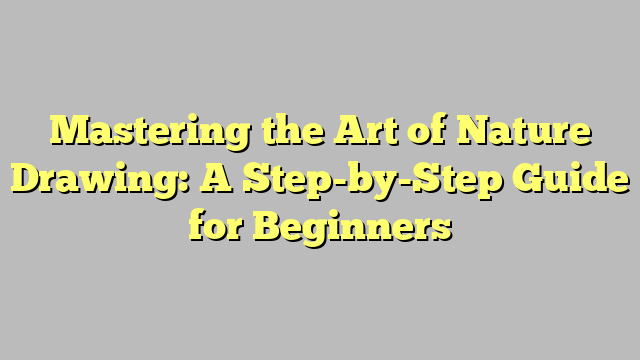Mastering the Art of Nature Drawing: A Step-by-Step Guide for Beginners
Mastering the Art of Nature Drawing: A Step-by-Step Guide for Beginners
Drawing from nature is a rewarding skill that allows you to capture the beauty of the natural world on paper. Whether you’re interested in sketching landscapes, plants, animals, or any other aspect of nature, this guide will help you start your journey. Follow these steps to master the art of nature drawing.
Getting Started
Before diving into the specifics of nature drawing, it’s important to gather the necessary tools and materials and to understand the basics of drawing.
Materials You Will Need
- Sketchbook or drawing paper
- Pencils (HB, 2B, 4B, 6B)
- Eraser
- Sharpener
- Optional: Colored pencils, watercolors, or other coloring materials
Understanding the Basics
Before you start drawing from nature, familiarize yourself with basic drawing techniques and concepts such as shading, perspective, and composition. This foundational knowledge will greatly improve your ability to capture the natural world.
Step-by-Step Guide to Nature Drawing
Follow these steps to begin your journey into nature drawing. Remember, practice is key to improvement, so don’t be discouraged by initial challenges.
Step 1: Observing Your Subject
Start by closely observing the subject you wish to draw. Notice the shapes, textures, and colors. Understanding your subject’s form and details is crucial for a realistic representation.
Step 2: Start with Basic Shapes
Begin your drawing by lightly sketching the basic shapes that make up your subject. This could be circles, ovals, rectangles, etc. These shapes will serve as a foundation for your drawing.
Step 3: Add Details
Once you have the basic shapes down, start adding details. Focus on one area at a time, and gradually build up the complexity of your drawing. Pay attention to the textures and patterns in your subject.
Step 4: Apply Shading
Shading adds depth and dimension to your drawing. Observe where the light hits your subject and where the shadows fall. Use a variety of pencil strokes to mimic these light and shadow areas.
Step 5: Final Touches
Review your drawing and add any final details or corrections. You might want to enhance certain areas or soften others. This is also the time to add color if you wish.
Tips for Successful Nature Drawing
- Practice regularly: The more you draw, the better you’ll become. Try to draw something from nature every day, even if it’s just a quick sketch.
- Be patient: Developing your drawing skills takes time. Don’t be discouraged by mistakes or imperfections; they’re part of the learning process.
- Study from life: Whenever possible, draw from real-life subjects rather than photos. This will improve your observational skills and help you capture the essence of your subject.
- Experiment with techniques: Don’t be afraid to try different drawing techniques or materials. Experimentation can lead to unique and interesting results.
Common Challenges and How to Overcome Them
| Challenge | Solution |
|---|---|
| Getting proportions right | Use a grid or reference points to help you maintain correct proportions. |
| Difficulty with textures | Practice drawing different textures separately. Experiment with various pencil strokes to mimic the texture of your subject. |
| Overworking the paper | Be mindful of the pressure you apply with your pencil. Start lightly and gradually build up to darker tones. |
| Lack of depth | Pay attention to light and shadow. Use shading to create depth and dimension in your drawings. |
Conclusion
Drawing from nature can be incredibly fulfilling. It allows you to connect with the natural world in a unique way and to express your creativity. By following this step-by-step guide and practicing regularly, you’ll develop the skills needed to create beautiful, realistic nature drawings. Remember, every artist was once a beginner, so embrace the learning process and enjoy your artistic journey.

